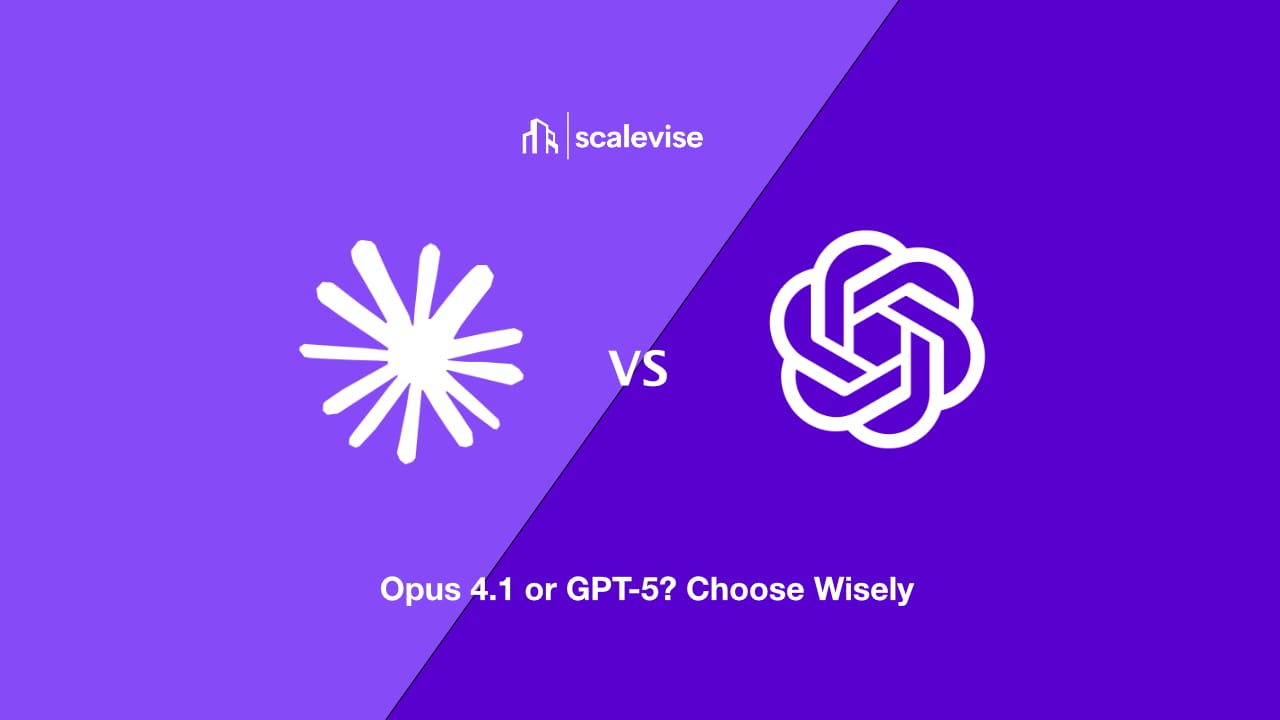Claude Opus 4.1 vs GPT-5: Which AI Model Is Right for Your Business?

Opus 4.1 or GPT‑5? Choose Wisely
Choosing the right LLM for your business is no longer just a technical decision it’s strategic. In a world where automation, data governance, and AI agents are core to your operations, selecting the wrong foundation could set you back months.
With GPT‑5 now fully released and Claude Opus 4.1 well established, the question becomes: which one aligns best with your use cases?
At Scalevise, we help companies build AI agents and automated workflows using the most advanced models available and that includes both Claude and GPT‑5. Below, we provide an up-to-date, side-by-side comparison to help you make the best architectural decision.
💬 Compare Models with the AI Agent
Claude Opus 4.1: What We Know
Claude 4.1 is Anthropic’s flagship model and continues to excel in areas like:
- 200,000 token context window (ideal for summarization and research)
- Long-term memory with natural tone in dialogue
- Excellent safety compliance (Anthropic’s Level 3 classification)
- Public API access via Anthropic API and Amazon Bedrock
- Strong performance in code reasoning (74.5% SWE-bench verified)
If your team is focused on internal tooling, enterprise data handling, and safety-first design, Claude remains a reliable and capable model.
Also See: Claude Comes with Privacy-First Memory Something GPT-5 Could Learn From
GPT‑5: What’s Now Confirmed
GPT‑5 is no longer speculation. It’s officially released and available through:
- ChatGPT Free / Plus / Pro / Team
- OpenAI API (GPT‑5, GPT‑5 Mini, GPT‑5 Nano)
What makes GPT‑5 different?
- Persistent memory support (per-agent, per-user, multi-session)
- Native agent support via the new ChatGPT Agents API
- Pricing tiers for scale: from $0.05 (Nano) to $1.25 (full model)
- Available in Make.com, Langchain, Node.js, CRM workflows
- Real-world deployment across onboarding, lead gen, compliance, and more
👉 Want the full picture? Check our GPT‑5 overview
GPT‑5 vs Claude Opus 4.1 Feature Comparison (Updated)
| Feature | Claude Opus 4.1 | GPT‑5 (Live) |
|---|---|---|
| Token context window | 200,000 tokens | 200K–1M tokens (tier-dependent) |
| Memory support | Long-term memory | Persistent memory (multi-session, per user) |
| Code performance | 74.5% SWE-bench (verified) | Not disclosed (expected parity or better) |
| Safety classification | Level 3 (Anthropic-defined) | Not disclosed |
| Agentic capabilities | Connectors: Drive, Notion, APIs | Native agent support (ChatGPT Agents API) |
| Availability | Public via API & Bedrock | Live in ChatGPT + OpenAI API (all tiers) |
| API pricing | $15/$75 per million tokens (in/out) | $1.25/$10 (GPT‑5), $0.25/$2 (Mini), $0.05/$0.40 (Nano) |
Strategic Use Cases for Both Models
Here’s how we at Scalevise implement both Claude and GPT‑5 depending on need:
When to Use Claude Opus 4.1:
- Deep summarization and document analysis
- Enterprise-grade safety requirements
- Use cases requiring long static context (legal, research)
- Teams already built on Bedrock or Anthropic’s API layer
When to Use GPT‑5:
- Dynamic, multi-turn agent workflows with memory
- CRM, onboarding, HR, or support automation
- AI copilots that retain individual user context
- Use cases requiring scalable, flexible pricing
Applications We’ve Already Deployed
Scalevise has delivered GPT‑5-powered automations including:
- AI Lead Qualification Agent
- GPT‑5 Business Workflow Orchestration
- Privacy-Aware Persistent Memory Agents
Each model has strengths it’s about matching the right one to the business problem.
Security and Ethical Considerations
Anthropic has leaned heavily into alignment and safety classification. Claude is the safe pick for regulated industries, where data sensitivity and hallucination risk are mission-critical.
OpenAI hasn’t yet revealed GPT‑5’s safety level, but the rollout of memory raises major compliance and data privacy questions. That’s why we’ve created this detailed guide:
GPT‑5 Persistent Memory: Security Blessing or Privacy Nightmare?
💬 Claude or GPT‑5? Ask Our Smart Sales Agent
Strategic Recommendations from Scalevise
For product teams, compliance officers, and automation engineers making platform choices:
- Choose Claude Opus 4.1 if your core focus is reasoning, legal safety, and document-heavy AI.
- Choose GPT‑5 if you want agents that think, remember, and evolve over time with users.
Want expert guidance on what fits your architecture, budget, and business goals?
